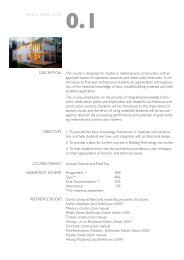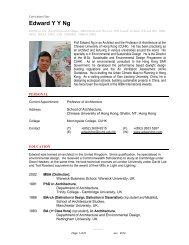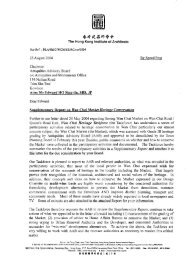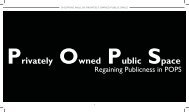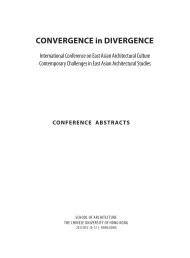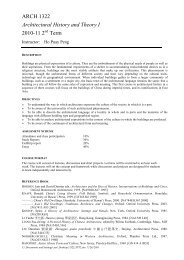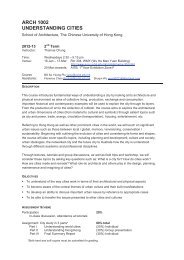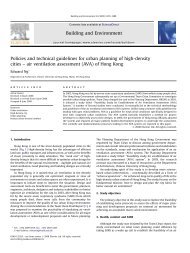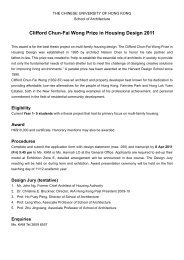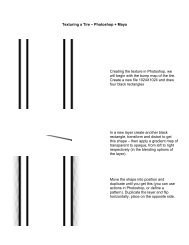Riyadh - School of Architecture
Riyadh - School of Architecture
Riyadh - School of Architecture
You also want an ePaper? Increase the reach of your titles
YUMPU automatically turns print PDFs into web optimized ePapers that Google loves.
DESIGN GUIDELINEOBJECTIVE \ ELEMENT1.HEAT AVIODANCEMinimize Heat Gain in FirstHand2.PASSIVETHERMAL TRANSFERBalancing & Taking Advantage<strong>of</strong> Dirunal TemperatureExtreme3.CONTROLLEDVENTILATIONSelective Screening andModificationWALLOrientationEspecially for elongated building(L>W), they should align to theEast-West axis, Ideally should tilt25deg. toward SE to avoid westernfacing. It is easier to shadethe envelope on North and Southbecause <strong>of</strong> high angle <strong>of</strong> sun.THERMAL MASSHeavily constructed (thick not less then 300mm)wall should be used, or even ro<strong>of</strong> to provide a largeheat bank to store up daytime heat for nighttimewarming use. Exact setup depends on capacityand amount <strong>of</strong> time lag required, careful calculationis needed.*DefinitionThermal Mass is the ability <strong>of</strong> a material to absorb, store, then in a later time releaseit, to help maintain a more even temperature pr<strong>of</strong>ile in a day. Good ThermalMass material depends on its heat capacity (kJ/m3K) and its thermal conductivity(W/mK). Example <strong>of</strong> good thermal mass include brick, earth, stone,and concreteCOLOURLight /reflective colour would minimize heat gainon exterior. For interior, cool/ bright colour wouldhelp light distribution and psychological comfort.While dark colour could be use on ground exposedonly in winter for heat gain, and also onspot where glare to interior would be problem.SHADING DEVICEDevices like louver could be adopted to protectbuilding envelope from excessive heat gain. East-West and North-South should use vertical andhorizontal system respectively for their sun angle.Design should ensure the device doesn’t adsorbtoo much heat to become a source <strong>of</strong> heat tothe building. Textured wall could work in similarways by self shading itself through pr<strong>of</strong>ile.Compact VolumeMinimize building surface to volume(S/V) ratio to minimize surfacearea exposed to heat gain.ROOFROOF FORMBarrel vault or dome are idealplanform for max. surface area toheat dissipation and min. area forsolar exposure.DOUBLE ROOFProvide a ventilated air layer in betweentwo ro<strong>of</strong> help bring awayro<strong>of</strong> heat gain. A more economicalternative is to use false ceiling toprovide that air gap. Effective airexchange in the gap is crucial.INSULATIONAddition <strong>of</strong> Insulation outside <strong>of</strong> thermal mass improvesthermal mass efficiency (fewer mass needed)although it is not a necessary. Both wall andro<strong>of</strong> <strong>of</strong> building can adopt such treatment. Extralayer need to be provided to protect the externalinsulation.OPENINGSIZE & POSITIONOpening should be done in a wayto block out high angle sun at hotseason and admit low angle sunin cooler time.East and West opening shouldbe restrained, espeically the laterone.TRANSFORMABLEIf operation allows, opening canbe partly closed <strong>of</strong>f in the dayand open up at night, by meanslike controllable cover. It will helpminimize admittance <strong>of</strong> too muchhot, dusty air in day and increasecross ventilation or radiation lossat night to cool down the building.Utilizing heat transfer potentialLIMITED, SMALL, HIGHIn hot-dry climate, air temperaturecan go above blood temperaturewhich renders ventilation at occupantlevel undesirable. Also thereis frequent harzard <strong>of</strong> Sand storm.Therefore opening should be keptto the minimum and small in size.High window is preferred to onlyfulfill need <strong>of</strong> air exchange.WIND TOWERWind Tower works in system <strong>of</strong> air intake and outake by differencein air pressure and temperature. The former is acheived when openingis either facing wind direction or opposing it to create intake andsuction respectively. Multidirectional wind shaft help system functionunder varies wind direction. Heating <strong>of</strong> the chimney enhance day exhaustand night air exchange to outside. Wind Tower could work withhumidifier to cool air through evaporative cooling



